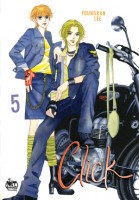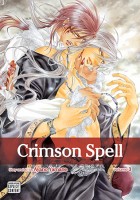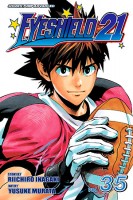My News and Reviews
Well, it wasn’t entirely intentional, but both of my in-depth manga reviews from last week featured manga released by Kodansha Comics. I managed to get my hands on an early copy of Hikaru Suruga’s Attack on Titan: No Regrets, Volume 1, the first installment in a short shoujo series focusing on Erwin and Levi and their pasts. It’s a welcome addition to the Attack on Titan canon and I enjoyed it a great deal. The second review was of Hinoki Kino’s No. 6, Volume 7 which may very well be the best volume yet in the series; it’s intense. I’d still love to read the original novels, but I’m glad that the manga adaptation is being released. I also had a bonus post last week—Random Musings: Cherry Bomb, Cinderseed, and Skyglass. Cherry Bomb is the mature imprint of Chromatic Press. Cinderseed was released through Cherry Bomb and is the prologue to the illustrated novel Skyglass which debuted earlier this month. I’m absolutely loving what I’ve seen of Skyglass so far.
And speaking of great stuff from Chromatic Press, I encourage everyone to check out its Kickstarter to release Gauntlent in print. As for other interesting things found online: The fifth part of Revealing and Concealing Identities: Cross-Dressing in Anime and Manga was posted at The Lobster Dance and focuses on Takako Shimura’s Wandering Son. Sean has a roundup of the recent license announcements from Seven Seas at A Case Suitable for Treatment. The UK-based comics publisher Breakdown Press is launching a series of classic and avant garde manga in translation, starting with Seiichi Hayashi’s Flowering Harbour in July. And last but not least, I discovered manga brog a newish site which already has some extremely interesting content, like a translation of a conversation between Taiyo Matsumoto, Inio Asano, and Keigo Shinzo.
Quick Takes
 Click, Volumes 5-8 by Youngran Lee. The relationship dynamics in Click are exceptionally complicated, made more complicated by the fact that Joonha’s sex and gender are in flux. After spending sixteen years of his life physically and mentally as male, the fact that he now has a female body has presented some problems. Initially he tried to separate himself from those closest to him, but now they’re back in his life. For better and for worse, Joonha still hasn’t fully explained the situation or his peculiar genetic condition. Some people treat him as the boy he once was, others treat him as the girl he seems to be now. Surprisingly enough, Joonha seems to care less and less about gender, more or less ignoring it in order to focus on other aspects of life. (Which really is how it should be.) Click is extremely melodramatic, emotions run high, and the plot can occasionally take some absurd turns. Despite being somewhat of a jerk, most everyone seems to be in love with Joonha and those feelings are returned. As a result, the manhwa forms an extraordinary mess of romantic entanglements.
Click, Volumes 5-8 by Youngran Lee. The relationship dynamics in Click are exceptionally complicated, made more complicated by the fact that Joonha’s sex and gender are in flux. After spending sixteen years of his life physically and mentally as male, the fact that he now has a female body has presented some problems. Initially he tried to separate himself from those closest to him, but now they’re back in his life. For better and for worse, Joonha still hasn’t fully explained the situation or his peculiar genetic condition. Some people treat him as the boy he once was, others treat him as the girl he seems to be now. Surprisingly enough, Joonha seems to care less and less about gender, more or less ignoring it in order to focus on other aspects of life. (Which really is how it should be.) Click is extremely melodramatic, emotions run high, and the plot can occasionally take some absurd turns. Despite being somewhat of a jerk, most everyone seems to be in love with Joonha and those feelings are returned. As a result, the manhwa forms an extraordinary mess of romantic entanglements.
 Crimson Spell, Volumes 3-4 by Ayano Yamane. The first two volumes of Crimson Spell were originally released in English by Media Blasters. I was thrilled when SuBLime rescued the license; Crimson Spell is my favorite Yamane series, and there are relatively few boys’ love manga set in a sword and sorcery fantasy world. On rereading the series, I realized that I had forgotten just how funny it can be, too. Granted, the third volume takes a fairly serious turn when Halvir is captured and Vald must go to his rescue. The plot is getting more involved, more and more characters are introduced, and Vald’s curse and the bond between him and his demon self are growing stronger. Halvir and Vald desperately need to sort out their feelings for one another, a particular thorny issue since Vald has now discovered that Halvir has been taking great pleasure in satisfying the carnal needs of the demon without Vald’s knowledge (or consent). Understandably, Vald isn’t particularly happy to learn this. With all of the drama, magic, and sword fights, and all of the smut to go along with it, I’m still loving Crimson Spell.
Crimson Spell, Volumes 3-4 by Ayano Yamane. The first two volumes of Crimson Spell were originally released in English by Media Blasters. I was thrilled when SuBLime rescued the license; Crimson Spell is my favorite Yamane series, and there are relatively few boys’ love manga set in a sword and sorcery fantasy world. On rereading the series, I realized that I had forgotten just how funny it can be, too. Granted, the third volume takes a fairly serious turn when Halvir is captured and Vald must go to his rescue. The plot is getting more involved, more and more characters are introduced, and Vald’s curse and the bond between him and his demon self are growing stronger. Halvir and Vald desperately need to sort out their feelings for one another, a particular thorny issue since Vald has now discovered that Halvir has been taking great pleasure in satisfying the carnal needs of the demon without Vald’s knowledge (or consent). Understandably, Vald isn’t particularly happy to learn this. With all of the drama, magic, and sword fights, and all of the smut to go along with it, I’m still loving Crimson Spell.
 Eyeshield 21, Volumes 35-37 written by Riichiro Inagaki and illustrated by Yusuke Murata. These last three volumes of Eyeshield 21 feel like an afterthought to the series more than anything else. The Christmas Bowl is over, but with the Youth World Cup about to begin Japan needs to pull together its all-star team. Basically this final arc amounts to an excuse to bring all of the favorite characters from the various Japanese teams together one last time. Despite it being a world championship, Eyeshield 21 seems to have lost the sense of urgency and emotional investment that was present during the battles in the Christmas Bowl. In part this is probably due to the fact that most of the members of the other national teams are new to the series, so any established rivalries or histories are missing. As expected, the championship game in the Youth World Cup comes down to Japan versus America. It’s a good game, but I found it to be rather anticlimactic in the end. Still, Eyeshield 21 is a lot of fun and as always Murata’s artwork is fantastic. I mean, the image of Ceasar riding a dinosaur? That’s some great stuff there.
Eyeshield 21, Volumes 35-37 written by Riichiro Inagaki and illustrated by Yusuke Murata. These last three volumes of Eyeshield 21 feel like an afterthought to the series more than anything else. The Christmas Bowl is over, but with the Youth World Cup about to begin Japan needs to pull together its all-star team. Basically this final arc amounts to an excuse to bring all of the favorite characters from the various Japanese teams together one last time. Despite it being a world championship, Eyeshield 21 seems to have lost the sense of urgency and emotional investment that was present during the battles in the Christmas Bowl. In part this is probably due to the fact that most of the members of the other national teams are new to the series, so any established rivalries or histories are missing. As expected, the championship game in the Youth World Cup comes down to Japan versus America. It’s a good game, but I found it to be rather anticlimactic in the end. Still, Eyeshield 21 is a lot of fun and as always Murata’s artwork is fantastic. I mean, the image of Ceasar riding a dinosaur? That’s some great stuff there.
 My Little Monster, Volume 2 by Robico. I’m quite enjoying My Little Monster. I particularly appreciate the series’ quirky, offbeat characters—a group of misfits with varying degrees of social awkwardness, ineptitude, and obliviousness. Shizuku is currently struggling to find the balance between her accidental friendships, her feelings towards Haru, and her studying, which had been the only thing in her life that had been constant. As for Haru, he’s starting to become more comfortable at school and around other people. But, though he means well, his more violent tendencies still cause some problems. Haru’s older brother is introduced in this volume and some of Haru’s troubled family life is revealed as well, adding some mystery and ominous undertones to what is generally a fairly lighthearted series. I like Robico’s dry sense of humor in My Little Monster. So far, the series has achieved a nice blend of more serious and more comedic elements. There are certainly some uncomfortable moments, but at this point the series has avoided becoming too heavy. I’m looking forward to reading more of My Little Monster.
My Little Monster, Volume 2 by Robico. I’m quite enjoying My Little Monster. I particularly appreciate the series’ quirky, offbeat characters—a group of misfits with varying degrees of social awkwardness, ineptitude, and obliviousness. Shizuku is currently struggling to find the balance between her accidental friendships, her feelings towards Haru, and her studying, which had been the only thing in her life that had been constant. As for Haru, he’s starting to become more comfortable at school and around other people. But, though he means well, his more violent tendencies still cause some problems. Haru’s older brother is introduced in this volume and some of Haru’s troubled family life is revealed as well, adding some mystery and ominous undertones to what is generally a fairly lighthearted series. I like Robico’s dry sense of humor in My Little Monster. So far, the series has achieved a nice blend of more serious and more comedic elements. There are certainly some uncomfortable moments, but at this point the series has avoided becoming too heavy. I’m looking forward to reading more of My Little Monster.
 JoJo’s Bizarre Adventure directed by Kenichi Suzuki and Naokatsu Tsuda. The first season of the JoJo’s Bizarre Adventure television anime series covers the first two parts of Hirohiko Araki’s inter-generational action manga epic. Phantom Blood is adapted in a mere nine episodes but still manages to hit most of the major plot points and remains coherent despite its quick pace. The remaining seventeen episodes are devoted to the second story arc, Battle Tendency. While they both obviously belong to the same anime series, the individual parts have their own stylistic quirks in the music and animation that give each its own feel. Phantom Blood has a classically oriented soundtrack and palette while Battle Tendency introduces dubstep and bright, fluorescent colors. Some shortcuts were taken with the animation in order to keep to a budget, some of which are more effective than others. However, the story remains entertaining and engaging, a mix of horror, revenge, and intense battles and action with strong psychological elements. JoJo’s Bizarre Adventure can be, well, bizarre and over-the-top, but I’ll gladly admit that I get a huge kick out of it.
JoJo’s Bizarre Adventure directed by Kenichi Suzuki and Naokatsu Tsuda. The first season of the JoJo’s Bizarre Adventure television anime series covers the first two parts of Hirohiko Araki’s inter-generational action manga epic. Phantom Blood is adapted in a mere nine episodes but still manages to hit most of the major plot points and remains coherent despite its quick pace. The remaining seventeen episodes are devoted to the second story arc, Battle Tendency. While they both obviously belong to the same anime series, the individual parts have their own stylistic quirks in the music and animation that give each its own feel. Phantom Blood has a classically oriented soundtrack and palette while Battle Tendency introduces dubstep and bright, fluorescent colors. Some shortcuts were taken with the animation in order to keep to a budget, some of which are more effective than others. However, the story remains entertaining and engaging, a mix of horror, revenge, and intense battles and action with strong psychological elements. JoJo’s Bizarre Adventure can be, well, bizarre and over-the-top, but I’ll gladly admit that I get a huge kick out of it.















